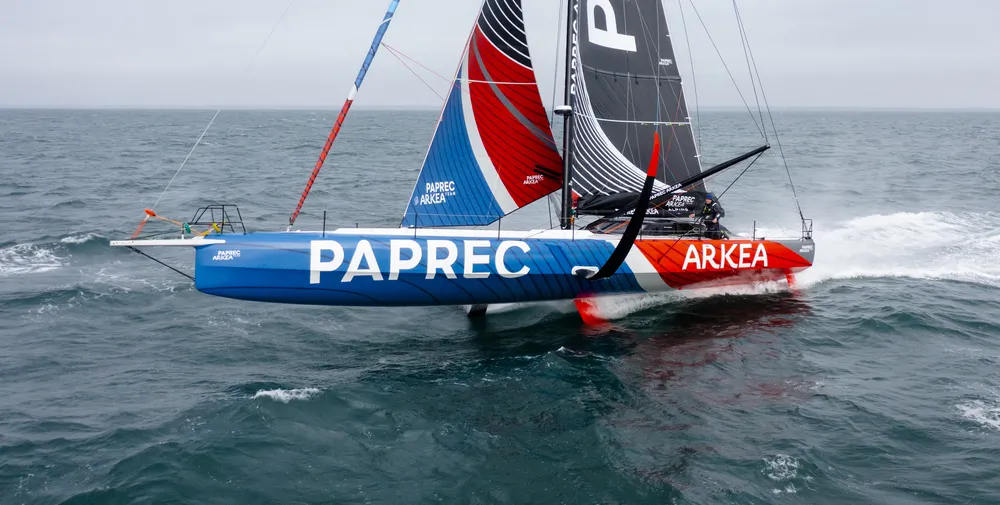These are always key moments in an offshore racing project. The launch of a boat is the starting point of a new adventure at sea and the achievement of months of work, in the shadow of the design office and the yard. On D-Day, the scenario is always the same: leaving the yard, craning, eyes of curiosity, cameras pointed at the boat and then the applause when the hull finally touches the water. There is also a combination of apprehension about the success of all these manoeuvres and excitement at finally seeing the result of the work being rewarded. "It's the accomplishment of a lot of work," smiles François Pernelle, head of the TR Racing (For People, formerly LinkedOut) design office. There is a lot of pride, even if it is only the first step. "We always feel better when the boat is finally at the dock," confides Gauthier Levisse, his alter-ego at Paprec Arkéa.
Safer, more reliable, fairer boats
Yoann Richomme and Thomas Ruyant's teams have launched two new boats, respectively in February and this Thursday, while awaiting the next ones to come: Charlie Dalin's Verdier design and Eric Bellion's Raison design. While everyone will be playing at spotting the similarities and differences between them and the previous new boats - eight have already been launched before them to compete in the next Vendée Globe* - all of them respect a very precise set of specifications, the famous 'class rules' determined by the IMOCA and made official in April 2021.
René Boulaire, who is in charge of measurement operations for the whole class, explains the basics: "The main issue is to ensure the safety of the skippers as much as possible, especially when we know the conditions they are exposed to during a round the world race. In short, we want the boats to be safer, more reliable and fairer." Several elements are common to all the boats: the mast, the sails, the keel ram, but also (and this is a new feature) the boom, the J2 forestay and the backstays. In addition, the rule regulates the volume of the foils (limited to 8m3).
Richomme: « There has been a pooling of effort »
The Paprec Arkéa and For People monohulls have a bit more in common : the first is a sistership of the second, the result of a joint work led by the Finot-Conq agency, the architect Antoine Koch and GSea Design for the structural calculations. "Yoann had already worked with Finot-Conq and as soon as we learned that a new Paprec Arkéa team was being set up, we talked to them," explains Antoine Koch. There was a pooling of efforts in research and development," continues Richomme, referring to the identical foils and rudders with For People. However, the deck, cockpit and roof plans are different.
However, for both teams, as for the others, one of the most studied issues is the ability to better pass through the waves and to deal with unstable conditions and sudden changes in speed. "We wanted a boat that required less regulation," explains Thomas Ruyant. The hull will allow us to sail flatter, downwind in the Deep South. It also has more freeboard, with less water on deck and less regulation required from the winch column. "We have tried to make a 4WD boat that will pass the sea better, offer good visibility and protect the sailor more," adds François Pernelle.
Ready to move from theory to practice
Yoann Richomme spoke of the "tulip-shaped" bow of his IMOCA. "The idea is to avoid nose-diving and to eject water to the sides so that there is minimal water on deck," explains Yoann Richomme. "To improve downwind performance, we tried to reduce the wet surface," continues Antoine Koch. He points out that these two boats are narrower than the previous generation, an aspect that is also notable in Charal 2. While there are many similarities between the two new IMOCAs, each team has developed its own solutions in terms of deck layout and ergonomics.
Paprec Arkéa have opted for a "semi-watertight" living area in the centre of the boat, which serves as a manoeuvring, watch and sleeping area. "The idea was to have a space as compact as possible where we could have access to everything: the computer, the winches and have a view to ensure a proper watch," explains Yoann. In Thomas Ruyant's team, they preferred to keep the philosophy of the former IMOCA LinkedOut. "The area inside is very clear, while the manoeuvring area at the rear remains open, Thomas did not want to feel encapsulated," continues François Pernelle. We wanted to keep his references and he liked that.
All that remains now is to move from theory to practice. Paprec Arkéa started sailing this week, and For People should do the same in a few weeks' time. In order to speed up the optimisation of his new boat, Thomas Ruyant will be able to count on Sam Goodchild, who will sail the ex-LinkedOut (her colours will be revealed on 14th April). "I'm expecting a lot from the pooling of resources and the sharing of ideas with him," smiles the skipper from the north of France. It should be noted that Paprec Arkéa and For People are expected to line up at the start of the Guyader Bermudes 1000 Race in Brest in early May, the first race of the season.
*Charlie Enright (11th Hour Racing Team) - Kevin Escoffier (Holcim – PRB)- Maxime Sorel (V and B – Monbana – Mayenne)- Jérémie Beyou (Charal)- Boris Herrmann (Malizia – Seaexplorer)- Sam Davies (Initiatives-Coeur)- Yannick Bestaven (Maître Coq V)- Paul Meilhat (Biotherm)



